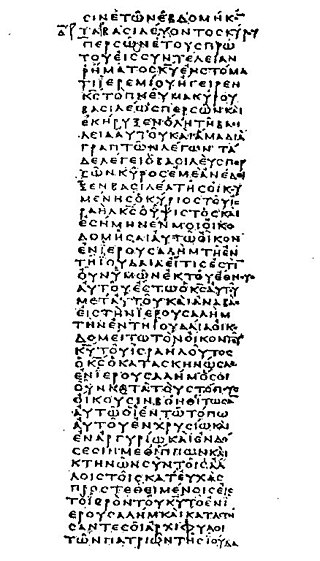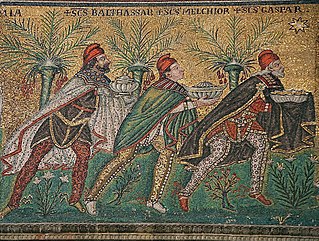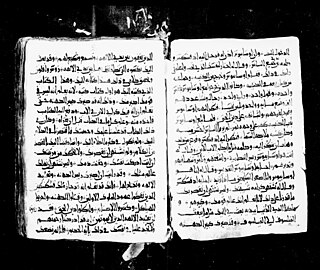
The Gospel of James is a second-century infancy gospel telling of the miraculous conception of the Virgin Mary, her upbringing and marriage to Joseph, the journey of the couple to Bethlehem, the birth of Jesus, and events immediately following. It is the earliest surviving assertion of the perpetual virginity of Mary, meaning her virginity not just prior to the birth of Jesus, but during and afterwards, and despite being condemned by Pope Innocent I in 405 and classified as apocryphal by the Gelasian Decree around AD 500, became a widely influential source for Mariology.

The first-century Jewish historian Flavius Josephus provides external information on some people and events found in the New Testament. The extant manuscripts of Josephus' book Antiquities of the Jews, written around AD 93–94, contain two references to Jesus of Nazareth and one reference to John the Baptist.

The Septuagint, sometimes referred to as the Greek Old Testament or The Translation of the Seventy, and abbreviated as LXX, is the earliest extant Greek translation of the Hebrew Bible from the original Biblical Hebrew. The full Greek title derives from the story recorded in the Letter of Aristeas to Philocrates that "the laws of the Jews" were translated into the Greek language at the request of Ptolemy II Philadelphus by seventy-two Hebrew translators—six from each of the Twelve Tribes of Israel.

In Christianity, the Biblical Magi, also known as the Three Wise Men, Three Kings, and Three Magi, are distinguished foreigners who visit Jesus after his birth, bearing gifts of gold, frankincense, and myrrh in homage to him. They are commemorated on the feast day of Epiphany—sometimes called "Three Kings Day"—and commonly appear in the nativity celebrations of Christmas.

The Gospel of Nicodemus, also known as the Acts of Pilate, is an apocryphal gospel purporting to derived from an original work written by Nicodemus, who appears in the Gospel of John as an acquaintance of Jesus. The title "Gospel of Nicodemus" is medieval in origin. The dates of its accreted sections are uncertain, but the work in its existing form is thought to date to around the 4th or 5th century AD.
The Testament of Adam is a Christian work of Old Testament pseudepigrapha that dates from the 2nd to 5th centuries AD in origin, perhaps composed within the Christian communities of Syria. It purports to relate the final words of Adam to his son Seth; Seth records the Testament and then buries the account in the legendary Cave of Treasures. Adam speaks of prayer and which parts of Creation praise God each hour of the day; he then prophesies both the coming of the Messiah and the Great Flood; and finally, a description of the celestial hierarchy of angels is given.
The Clementine literature is a late antique third-century Christian romance or "novel" containing a fictitious account of the conversion of Clement of Rome to Christianity, his subsequent life and travels with the apostle Peter and an account of how they became traveling companions, Peter's discourses, and finally Clement's family history and eventual reunion with his family. To reflect the pseudonymous nature of the authorship, the author is sometimes referred to as Pseudo-Clement. In all likelihood, the original text went by the name of Periodoi Petrou or Circuits of Peter; sometimes historians refer to it as the "Basic Writing" or "Grundschrift".

4 Maccabees, also called the Fourth Book of Maccabees and possibly originally known as On the Sovereignty of Reason, is a book written in Koine Greek, likely in the 1st or early 2nd century. It is a homily or philosophic discourse praising the supremacy of pious reason over passion. It is a work that combines Hellenistic Judaism with influence from Greek philosophy, particularly the school of Stoicism.

Joseph and Asenath is a narrative that dates from between 200 BCE and 200 CE. It concerns the Hebrew patriarch Joseph and his marriage to Asenath, expanding the fleeting mentions of their relationship in the Book of Genesis. The text was translated widely, including into Amharic, Arabic, Armenian, Early Modern German, Latin, Middle English, Old French, Romanian, Serbian and Syriac.

The Ascension of Isaiah is a pseudepigraphical Judeo-Christian text. Scholarly estimates regarding the date of the Ascension of Isaiah range from 70 AD to 175 AD. Many scholars believe it to be a compilation of several texts completed by an unknown Christian scribe who claimed to be the Prophet Isaiah, while an increasing number of scholars in recent years have argued that the work is a unity by a single author that may have utilized multiple sources.

The Revelation of the Magi is an early Christian writing in Syriac. It is part of the broader set of New Testament apocrypha, religious stories of early Christian figures that did not become canonized in the New Testament. The Revelation of the Magi is pseudepigraphically attributed to the testimony of the Magi, also known as the Wise Men, whose story appears in the Gospel of Matthew's account of the birth of Jesus. It is preserved as part of the Zuqnin Chronicle, an 8th-century Syriac religious history.

Buddhism was known in the pre-Christian Greek world through the campaigns of Alexander the Great, and several prominent early Christian fathers, including Clement of Alexandria and St. Jerome, were aware of the Buddha, even mentioning him in their works. However, the majority of modern scholars who have studied both Buddhism and Christianity hold that there is no direct historical evidence of any influence by Buddhism on early Christianity. Scholars generally consider any such influence implausible given that first century Jews are highly unlikely to have been open to far eastern concepts that appeared opposed to some of their basic beliefs.

The Nativity of Jesus has been a major subject of Christian art since the 4th century.
Christianity began as a Second Temple Judaic sect in the 1st century in the Roman province of Judea, from where it spread throughout and beyond the Roman Empire.

Christianity in the 1st century covers the formative history of Christianity from the start of the ministry of Jesus to the death of the last of the Twelve Apostles and is thus also known as the Apostolic Age. Early Christianity developed out of the eschatological ministry of Jesus. Subsequent to Jesus' death, his earliest followers formed an apocalyptic messianic Jewish sect during the late Second Temple period of the 1st century. Initially believing that Jesus' resurrection was the start of the end time, their beliefs soon changed in the expected Second Coming of Jesus and the start of God's Kingdom at a later point in time.
Early Christianity, otherwise called the Early Church or Paleo-Christianity, describes the historical era of the Christian religion up to the First Council of Nicaea in 325. Christianity spread from the Levant, across the Roman Empire, and beyond. Originally, this progression was closely connected to already established Jewish centers in the Holy Land and the Jewish diaspora throughout the Eastern Mediterranean. The first followers of Christianity were Jews who had converted to the faith, i.e. Jewish Christians, as well as Phoenicians, i.e. Lebanese Christians. Early Christianity contains the Apostolic Age and is followed by, and substantially overlaps with, the Patristic era.

The Acts of Thaddeus is a Greek document written between 544 and 944 CE which purports to describe correspondence between King Abgar V of Edessa and Jesus, which results in Jesus' disciple Thaddeus going to Edessa.

Vindicta Salvatoris is a text of New Testament Apocrypha that expands the story of the aftermath of Jesus's execution. It was often presented as a supplement to the Gospel of Nicodemus. The oldest known copies are two Latin versions of the Vindicta Salvatoris, both dated to the 8th or 9th centuries and likely when the work was authored. The work is thought to have been composed in southern France, perhaps the Aquitaine region.

The Julian Romance is fictionalized prose account of the reign of the Roman emperor Julian the Apostate. It was written sometime between Julian's death in 363 and the copying of the oldest known manuscript in the sixth century. It was probably written in Edessa in Syriac, the language of all surviving copies. An Arabic adaptation had been made by the tenth century.

The Pilate cycle is a group of various pieces of early Christian literature that purport to either be written by Pontius Pilate, or else otherwise closely describe his activities and the Passion of Jesus. Unlike the four gospels, these later writings were not canonized in the New Testament, and hence relegated to a status of apocrypha. Some writings were quite obscure, with only a few ancient textual references known today; they merely survived through happenstance, and may not have been particularly widely read by early Christians in the Roman Empire and Christians in the Middle Ages. Others were more popular. The most notable example was the Gospel of Nicodemus, which proved quite popular and influential in medieval and Renaissance Christianity.















